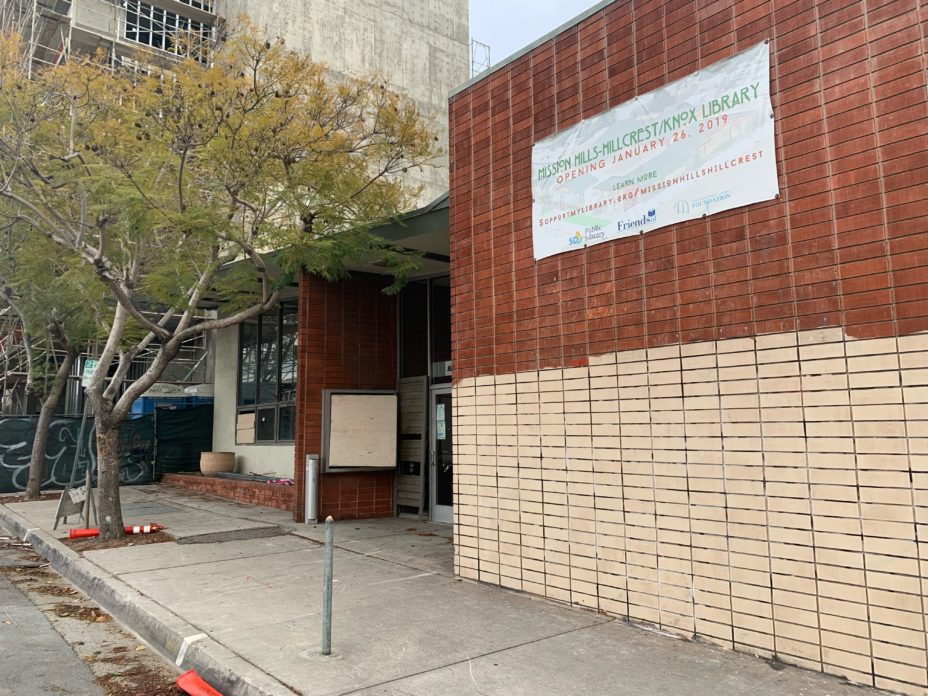Dilatory City Makes Fate of Old Mission Hills Library Uncertain, Appeal Pending
By Jennifer Machian
The old Mission Hills Library was once a vibrant community treasure. Located at the western entrance of Mission Hills, the library enticed patrons of all ages, with its shiny wall of windows and iconic cantilevered roof.
Long-time Mission Hills resident, Caroline Ridout Stewart, who frequented the library as a sixth grader in the 1960s, recalls the library warmly, as a recreational space for children and teens to gather after school. “The windows were always filled with posters” advertising community events and “there used to be books out front [on a cart] you could buy.”
But, the library’s heyday as a hub of neighborhood activity is long past. The library was vacated in January 2019 and has sat empty ever since. A high-rise has sprouted-up next door, just inches from the library’s roofline.
To a casual observer, it is evident that the City is not maintaining the building well. The same 2018 banner advertising the new Mission Hills-Hillcrest Branch Library hangs on the stacked-brick facade, some windows are broken and boarded-up, trash is strewn behind the glass doors of the entryway, and graffiti that marred the brick has been covered with sickly yellow paint. “It’s ugly. It’s an eyesore right now,” says Ridout Stewart.
Efforts at preserving the building have been made. In August 2019, the preservation advocacy group Mission Hills Heritage filed a nomination to designate the library as a historic resource in recognition that the building is the only Mid-Century-Modern style building located in Mission Hill’s core business district.
“[The old Mission Hills Library is] part of an important period of time that no longer exists,” says Ron May, a registered professional archeologist of Legacy 106, who authored the nomination report. “You’ll never have a building built like that again because the building standards don’t allow these kinds of buildings.”
In September 2020, the City’s Historic Resources Board agreed and designated the building, which the City owns, as a historic resource.
Yet, the historical designation has not spurred City officials to bring a plan into focus. Instead, ever since then-Mayor Kevin Faulconer’s “request for development” to use the site for homeless housing was scrapped, City officials have been evasive.
For the last two years, and as recently as this year, the Director of the Mission Hills Community Preschool, Anna DiMartino, has sought information from the City about the adaptive re-use of the building as a pre-school and possibly an after-school program.
DiMartino has communicated with no less than six City officials (involved in the management of City-owned property) to determine whether the preschool could lease or buy the building, but after being “shuffled around and shuffled around, . . . pretty much nothing happened.” Despite DiMartino’s efforts, it is the City’s official position that “[t]here currently is no application for any proposed project for the site.” According to DiMartino, the City has never directed her to fill out an application.
Complicating matters is the fact that Mission Hills resident, Clint Daniels, filed an appeal in September 2020 contesting the library’s historical designation. While the San Diego City Council has resolved multiple other appeals of historical designations filed after Daniels’ appeal, the City Council has left Daniels’ appeal pending for over two years, casting a cloud of doubt over the building’s future.
Barry Hager, Mission Hills Heritage co-founder and advisor, says that his organization has communicated with City Officials multiple times, requesting that the City “protect the building and also bring the appeal forward.” These calls for action had largely gone unheeded until this February, when the City confirmed in an official statement that “staff is actively working on docketing the item for a City Council Hearing . . . anticipated to take place in late Spring 2023.”
Going forward, trying to divine the City’s intentions for the building is like reading tea leaves. “It’s kind of a mystery now,” says Hager.
One possibility, recounted by May, is that the City, by ignoring the building, seeks to eventually condemn the property in order to circumvent the requirement that it maintain the building as a historic resource and pursue more aggressive development of the site. Termed “demolition by neglect,” May opined that “the longer [the library] just sits, the more likely it is to get condemned.”
What is more certain, is that the condition of the building should not affect the legal merits of the appeal. Hager warns, however, that as a “practical issue” the building’s deteriorated state could affect its future use: Any potential future users would have to take on the existing deferred maintenance. Indeed, although the preschool remains very “interested in exploring the possibility [of using the building,]” DiMartino admits that the damage could impact the preschool’s ability to do so.
Whatever the City’s plans, a majority of individuals favored saving the old branch library in a survey conducted by the Mission Hills Business Improvement District in 2018. Hager acknowledges that the City’s inaction has put this goal in jeopardy, but maintains that “It’s always been our hope that the City would allow the building to be adaptively reused for the benefit of the community.”
A contrary outcome involving loss of the structure, in the words of May, would sadly deny “the younger generations the ability to know the history of where they lived.”
Jennifer Machian has a degree in Mass Communications from the University of Minnesota’s Hubbard School of Journalism and is a Mission Hills resident.

Category: Architecture, Authors, Books, Education, feature, Historical, Local News, Nonprofit, Seniors, Students







